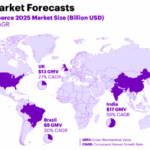A new study by Juniper Research forecasts a significant expansion in the global e-commerce market, driven not by specific product categories, but by the increasing adoption of alternative payment methods (APMs).
APMs as a Catalyst for Growth
The research predicts a 63% surge in the global e-commerce market by 2029, reaching a staggering $11.4 trillion. This growth is primarily attributed to APMs, which enable consumers in regions with limited credit card penetration to participate in online shopping.
Defining Alternative Payment Methods
APMs encompass a wide range of cardless and cashless payment options, including digital wallets (like Apple Pay and Google Pay), account-to-account transfers, and other emerging technologies. These methods provide greater flexibility and convenience for consumers, especially in markets where traditional payment methods may be limited.
Breaking Down Barriers
The widespread adoption of APMs is breaking down barriers that have historically hindered e-commerce growth in certain regions. By offering secure and convenient payment options, APMs are empowering consumers to participate in the digital economy, regardless of their geographic location or financial circumstances.
Implications for E-commerce Businesses
The growth of APMs presents both opportunities and challenges for e-commerce businesses. To capitalize on this trend, businesses must ensure they offer a diverse range of payment options to cater to the preferences of their customers. Additionally, staying updated on emerging APM technologies and regulatory changes will be crucial for businesses to remain competitive.
The global e-commerce market is poised for significant growth, driven in part by the increasing adoption of alternative payment methods. As APMs continue to evolve and expand their reach, we can expect to see even more rapid growth in the years to come. DMSMatrix will continue to monitor developments in this space and provide updates on the latest trends and innovations in e-commerce.










